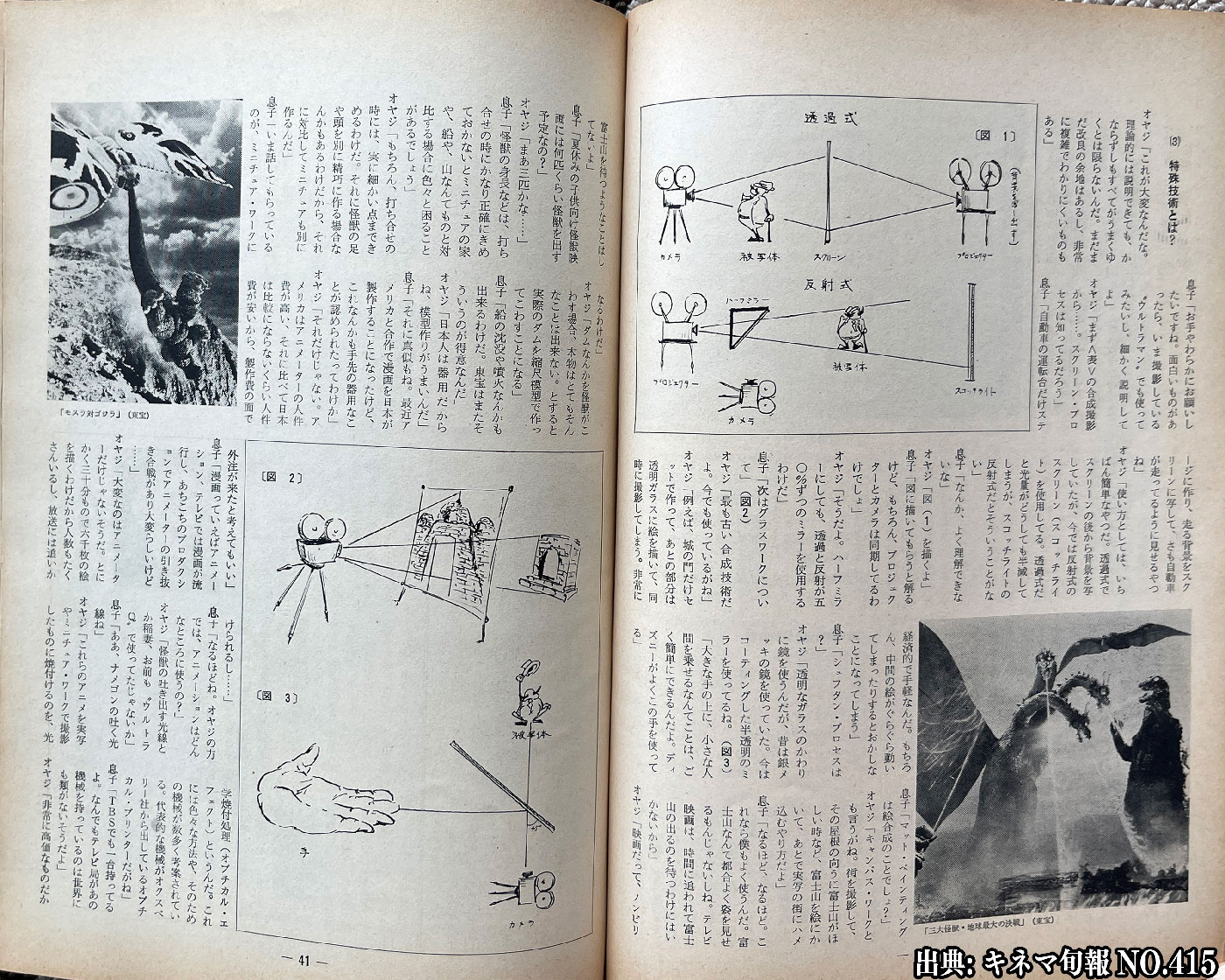2.18.2023
Eiji and Hajime discuss SPFX Movies – Pt 2

3 特殊技術とは?
3 What is special technology?
オヤジ「これが大変なんだな。 理論的には説明できても、かならずしもすべてがうまくゆくとは限らないんだ。まだまだ改良の余地はあるし、非常に複雑でわかりにくいものもある」
Old man: “This is hard. Even if I can explain it theoretically, it is not always all good. There is still room for improvement, and some are very complicated and difficult to understand.”
息子「お手やわらかにお願いし たいですね。面白いものがあったら、いま撮影している”ウルトラマン”でも使ってみたいし、細かく説明してよ」
Son: “I would like to ask for a soft hand. If there is something interesting, I want to use it as “Ultraman“ which I am shooting now, and explain it in detail.”
オヤジ「まず表Vの合成撮影 から……。スクリーン・プロセスは知ってるだろう」
Old Man: “First of all, from the synthetic shooting of Table V … you will know the screen process.”
息子「自動車の運転台だけステージに作り、走る背景をスクリーンに写して、さも自動車が走ってるように見せるやつね」
Son: “I made only the driver’s cab on the stage, copied the running background on the screen, so that the car is running. The guy who shows it. “
オヤジ「使い方としては、いちばん簡単なやつだ。透過式でスクリーンの後から背景を写していたが、今では反射式のスクリーン(スコッチライト)を使用してる。透過式だと光量がどうしても半減してしまうが、スコッチライトの反射式だとそういうことがない」
Old Man: “The easiest way to use it. The background was taken after the screen with a transparent type, but now I use a reflective screen (scotch light). It will be, but there is no such thing as a scotch light reflection type. “
息子「なんか、よく理解できないな」
Son: “I can’t understand something well”
オヤジ「図(1)を描くよ」
Old Man: “I will draw a figure (1)”
息子「図に描いてもらうと解るけど、もちろん、プロジェクターとカメラは同期してるわけでしょ」
Son: “I understand that I draw it in the figure, but of course the projector and the camera are synchronized.”
オヤジ「そうだよ。ハーフミラにしても、透過と反射が五 〇%ずつのミラーを使用するわけだ」
Old Man: “That’s right. Even if it is a half-missing, it uses a mirror of 50%of transparency and reflection.”
息子「次はグラスワークについて」(図2)
Son: “Next is about glass work” (Fig. 2)
オヤジ「最も古い合成技術だよ。今でも使っているがね」
Old Man: “It’s the oldest synthetic technology. I still use it.”
オヤジ「例えば、城の門だけセットで作って、あとの部分は透明ガラスに絵を描いて、同時に撮影してしまう。非常に経済的で手軽なんだ。もちろ ん、中間の絵がぐらぐら動いてしまったりするとおかしなことになってしまう」
Old Man: “For example, I make a set of the castle gate, draw a picture on a transparent glass and shoot it at the same time. It is very economical and easy. Of course, the middle picture moves around. If you get rid of it, it will be strange. “
息子「シュフタン・プロセスは ?」
Son: “What is the Schuftan process?”
The Schüfftan process is a movie special effect named after its inventor, Eugen Schüfftan (1893–1977). The technique consists of covering part of the camera’s view with a mirror, allowing filmmakers to assemble an image from multiple parts. (Source: Wikipedia)
オヤジ「透明なガラスのかわりに鏡を使うんだが、昔は銀メッキの鏡を使っていた。今はコーティングした半透明のミラーを使ってるね。(図3) 「大きな手の上に、小さな人間を乗せるなんてことは、ごく簡単にできるんだよ。 ディズニーがよくこの手を使って る」
Old man: Instead of transparent glass, mirrors are used, but in the past silver-plated mirrors were used. Now, coated translucent mirrors are used. It’s very easy to get a human on board, and Disney does it a lot.”
息子「マット・ペインティングは絵合成のことでしょ?」
Son: “Matte painting is about picture composition, right?”
オヤジ「キャンパス・ワークとも言うがね。街を撮影して、その屋根の向うに富士山がほしい時など、富士山を絵にかいて、あとで実写の街にハメ込むやり方だよ」
Old man: “It’s called campus work. When you want to shoot a city and want Mt.Fuji beyond the roof, it’s a way of painting Mt.Fuji and later inserting it into a live-action city.”
息子「なるほど、なるほど。これなら僕もよく使うんだ。富士山なんて都合よく姿を見せるもんじゃないしね。テレビ 映画は、時間に追われて富士山の出るのを待つわけにはいかないから」
Son: “I see, i see. I use this a lot too. Fuji doesn’t show itself conveniently. Television movies are pressed for time and can’t wait for Mt. Fuji to appear.”
オヤジ「映画だって、ノンビリ富士山を待つようなことはしてないよ」
Old man: “Even movies don’t wait for Mt. Fuji to be relaxed.”
息子「夏休みの子供向け怪獣映画には何匹くらい怪獣を出す予定なの?」
Son: “How many monsters are you planning to put in a monster movie for children during the summer vacation?”
オヤジ「まあ三匹かな……」
Old man: “Well, maybe three…”
息子「怪獣の身長などは、打ち合せの時にかなり正確にきめておかないとミニチュアの家や、船や、山なんてものと対比する場合に色々と困ることがあるでしょう」
Son: If you don’t decide the height of the monster quite accurately at the time of the meeting, there will be various problems when comparing it with miniature houses, ships, and mountains.
オヤジ「もちろん、打ち合せの時には、実に細かい点まできめるわけだ。それに怪獣の足 や頭を別に精巧に作る場合なんかもあるわけだから、それに対比してミニチュアも別に作るんだ」
Old man: Of course, when we have a meeting, we really get down to the smallest details.In addition, there are cases where the monster’s legs and head are made separately, so we also make miniatures separately.
息子「いま話してもらっている のが、ミニチュア・ワークになるわけだ」
Son: “What you are talking about now will be a miniature work.”
オヤジ「ダムなんかを怪獣がこわす場合、本物はとてもそんなことは出来ない。とすると実際のダムを縮尺模型で作ってこわすことになる」
Old man: “If a monster destroys a dam, the real thing can’t do that. If so, you’ll have to make a scale model of the actual dam and destroy it.”
息子「船の沈没や噴火なんかも 出来るわけだ。東宝はまたそういうのが得意なんだ」
Son: “The ship can sink or erupt. Toho is good at that sort of thing again.”
オヤジ「日本人は器用だからね、模型作りがうまいんだ」
Old man: “Japanese people are skillful, so they are good at making models.”
息子「それに真似もね。最近アメリカと合作で漫画を日本が 製作することになったけど、 これなんかも手先の器用なことが認められたってわけか」
Son: “And also imitate. Japan recently decided to produce a manga in collaboration with the United States.
オヤジ「それだけじゃない。アメリカはアニメーターの人件 費が高い、それに比べて日本は比較にならないくらい人件費が安いから、製作費の面で外注が来たと考えてもいい」
The old man: “That’s not all. The labor costs for animators in the US are high, and in comparison, the labor costs in Japan are incomparably low.”
息子「漫画っていえばアニメーション、テレビでは漫画が流 行し、あちこちのプロダクシ ョンでアニメーターの引き抜き合戦があり大変らしいけど……」
Son: Manga is animation and is popular on TV, and it seems like it’s going to be a tough time with animator picking battles in various productions…”
オヤジ「大変なのはアニメーターだけじゃないそうだ。とにかく三十分もので六千枚の絵を描くわけだから人数もたくさんいるし、放送には追いかけられるし……」
Old Man: “It seems that animators aren’t the only ones having trouble. Anyway, they draw 6,000 pictures in 30 minutes, so there are a lot of people, and the broadcast will catch up with him…”
息子「なるほどね。オヤジの方 では、アニメーションはどんなところに使うの?」
Son: “I see. Old man, what kind of place do you use animation?”
オヤジ「怪獣の吐き出す光線と稲妻、お前も“ウルトラ Q” で使ってたじゃないか」
Old man: “You used the rays and lightning that monsters spew out in Ultra Q, didn’t you?”
息子「ああ、ナメゴンの吐く光線ね」
Son: “Oh, the rays that Namegon spits out.”
オヤジ「これらのアニメを実写やミニチュア・ワークで撮影したものに焼付けるのを、光学焼付処理(オプチカル・エ フェクト)というんだ。これ には色々な方法や、そのため の機械が数多く考案されている。代表的な機械がオクスペリー社から出しているオプチカル・プリンターだがね」
The old man: “The process of printing these animations onto live-action or miniature works is called optical printing. Various methods and machines have been devised for this purpose. A representative machine is the optical printer produced by Oxpery.”
息子「TBSでも一台持ってる よ。なんでもテレビ局があの機械を持っているのは世界にも類がないそうだよ」
Son: “TBS has one. It seems that there is no other TV station in the world that has such a machine.”
オヤジ「非常に高価なものだからね」
Old man: “It’s very expensive.”
Caption
「三大怪獣 地球最大の決戦」(東宝)
Ghidorah The Three-Headed Monster (Toho)
[図 1] Figure 1
カメラ camera
スクリーン screen
写体 body
透過式 transparent
プロジェクター projected
プロジェクター projected
ハーフミラー half mirror
カメラ camera
反身式 reverse style
写体 body
スクリーン screen
[図 2] Figure 2
[図 3] Figure 3
体 body
手 hand
カメラ camera
Caption
「モスラ対ゴジラ」(東宝)
Mothra vs Godzilla (Toho)